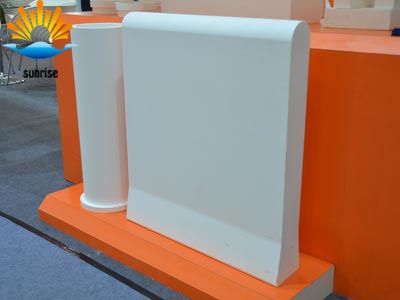Casting of cast-cast corundum bricks is required before casting. The temperature during melt casting should be controlled at 1960-1980 degrees. In order to increase the casting density, it can be layered and poured. The layer is cast for 10-20min. When the current casting surface temperature is cooled to 1680-1700, the next layer is poured to the melt. The addition of an electrofusion block similar to the melt composition increases the density of the melt flow during casting. The melt cast during the casting of corundum bricks must ensure good fluidity and avoid overheating, because overheating will cause the melt to absorb gas, and the shrinkage rate will increase correspondingly after casting into the mold, and the casting will also be produced. Shrinkage and cracking.
The cooling and cooling process of cast-cast corundum brick castings is roughly divided into four stages: melt flow (casting), heat dissipation, melt solidification hardening (crystallization), and hardened casting cooling. In the melt hardening process, its structure is forming. In the initial stage, the temperature of the casting skin drops sharply, and the melt rapidly dissipates heat to the model to form an extremely dense portion, and the crystal phase precipitates to form the crystallite and mesomorphic regions of the casting. The remaining melt of the cast-cast corundum brick is mainly concentrated in the middle portion of the casting near the casting surface, and a coarse crystal structure is formed later. Since the crystallization extends from the edge to the center, when the peripheral crystal of the casting hardens and begins to cool, the center of the casting is still a high-temperature liquid melt, and the temperature difference between the edge and the center is quite large, and a crack-forming stress is generated in the casting, and the internal and external hardening is caused. The greater the speed difference, the greater the thermal stress. Therefore, the cooling process of castings is of great significance to the quality and structure of cast-cast corundum bricks.
The casting is annealed after demolding, in effect controlling the hardening (crystallization) and cooling rate of the casting. There are two ways to anneal corundum bricks: natural annealing and controlled annealing. Natural annealing relies on a good thermal insulation layer on the outside of the casting to cool the casting smoothly and slowly. The cooling rate can be adjusted by the thickness of the diatomaceous earth or expanded vermiculite layer outside the mold. Controllable annealing is to remove the casting that has been hardened by the skin from the mold or the mold into a small tunnel kiln and slowly cool it according to the specified annealing curve.

Qualified products of the cast-cast corundum brick that have been annealed must be machined before entering the warehouse. Due to the high hardness and high strength of corundum, diamond tools are used for processing. The castings are cut, ground, punched, etc., so that the cast-cast corundum bricks have precise geometric shapes, smooth and flat surfaces and precise dimensions for installation.